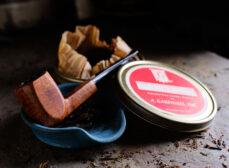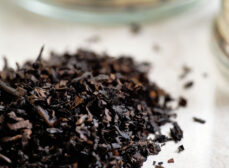
The late Bill Unger, long-time secretary/treasurer of the North American Society of Pipe Collectors and editor of the Pipe Collector newsletter, was often quoted as saying, “If you have one pipe, you’re a pipe smoker. If you have two pipes, you’re a collector.”
The question of what makes an aggregate of pipes an actual “collection” is something that I’ve often struggled with, and every attempt to pin things down has found me in the weeds. Collectors of most objets d’art tend to have some sort of focus, and to take the stance that my focus is on “pipes” has always felt a bit like a cheap way out. I have friends who collect a certain shape, or a certain maker’s work, or pipes from a specific country or era. One specializes in straight grain, always seeking the next incremental step towards perfection, while never accumulating too many pieces. I, on the other hand, have never been a specialist, but the term generalist doesn’t adequately describe my proclivity either. Over the years, as my tastes have changed and evolved, I’ve chased many different styles of pipe, resulting in an embarrassingly large gathering of briars that range from the most traditional to the frankly weird. Is it really a “collection” when the only thing that ties its elements together is not a thread but a mooring rope?
Once, I was most interested in bulldogs, especially the squat bowl variant. One of my first good pipes was a GBD in this shape; so early along my collecting journey, I didn’t even know what the shape was called, but I was attracted by its almost UFO-like styling – I just found the shape engaging, Learning more about classic shapes, I began to look at other bulldog variants, and found myself gravitating towards the bent versions, especially rhodesians, with their round shanks, squat, voluptuous bulldog-esque bowls, and that wonderfully comfortable half-bend. I gathered quite a few of them, ranging in size from small to quite large, and thought I’d found my niche.
Of course, this wouldn’t last forever, and soon other shapes caught my attention. The prince, long and elegant, with its wider bowl and gentle curve seemed like maybe it was the perfect shape. Its slender shank and long stem result in a light pipe that keeps the smoke out of your eyes. I’ve also often posited that there is no better “pointing pipe” than the prince.
Then came the lovats. Their compact shape, short saddle mouthpieces and capacious bowls seemed to be my ideal. And, speaking of compact shapes, the little “brucianaso,” exemplified by the Castello #10, was so appealing, I found myself chasing them at a time when they were exceedingly rare.
The billiard, at one time, seemed sort of boring to me, but it is such a classic shape, and when cut really nicely, has its own beauty and charm. Now, I have quite a few of them. And there are the apples, with their thick, curvaceous bowls that feel so good in the hand. And the Castello #55 pot, one of Carlo Scotti’s personal faves. Get the picture? Like a butterfly, I have always flitted from shape to shape, extracting the nectar of whatever form appealed to me at the moment before moving on to the next flower. But it was always the more classic shapes, the pipes from England, France, and to a degree, those from Italy that held my interest.
Then, in the late 1990s, something changed, and I became attracted to some of the Danish styles, not so much the wild “freehand” shapes, but the modernist interpretations of classic pipe forms that came from the minds and hands of the early masters. The direction of Danish pipe making was born out of a functionalist design aesthetic, where minimalism and function, elegance and nuance held priority over the ornate. These makers took familiar forms and rendered them with sleeker lines, softer curves, and a more minimalist approach. Some were additionally inspired by nature, bringing new words to the vocabulary of pipe shapes. I was intrigued, and as more of these shapes found their way into my group, they scribbled another page of an increasingly disorganized book. They didn’t displace my beloved classics, but expanded my appreciation in yet another direction.
Oh, and those crazy freehands? What can I say; some of those shapes are so wildly conceived, how could I ignore them? The butterfly finds flowers wherever they are.
Mostly, I’ve just accepted, or ignored my rather mercurial tastes, but once in a while, something happens to bring my “strategy” into question. The other day, I was enticed by a beautiful piece by American maker Ryan Alden. I’ve known Ryan for years, and have bought a couple of his pieces, but this pipe lived outside of his norm, and mine. I had to have it. (It’s the sandblast piece in the accompanying photographs.) I’m not even sure I know what to call it. Urchin-esque? Squat apple? Cinnamon bun? Tomato? Nothing quite fits, but, as soon as I had it in hand, I realized that a couple other pieces I have bear similar profiles, like the pictured Bengt Carlson rusticated and bamboo-shanked piece by Taiwan’s Jerry Zenn. Will these three pipes become the cornerstone of a new direction, a new sub-collection? I’m not sure, but at the moment, I kind of hope so.
I certainly have more than one pipe, so in deference to a dear departed friend’s memory, I’ll just try to accept his definition and find peace within my capricious nature.
I am a pipe collector.





















Hi Greg,
Thank you for another enjoyable article! It’s good to have you back, sharing your insights here.
At one point you ponder whether what you have is a collection, as it isn’t as tightly structured, or themed, as other collections. My thought is simply this, the collection, at whatever point it is at, is unified by one important metric. These are all pipes that have interested you and you have selected them and added the to your collection. That’s as good a qualifier as there is. Yours is also a collection by journey.
In much the same way, my collection, or pile as I define it is the same thing, representing the range of my interests, shape, makes, periods, countries, that have interested me at one time or another. These pipe are pathways.
I would imagine that something similar happen with tobaccos. We go through a journey with tobacco blends as well, in much the same way we go through a journey with pipes. Might be interesting to hear about your tobacco journey.